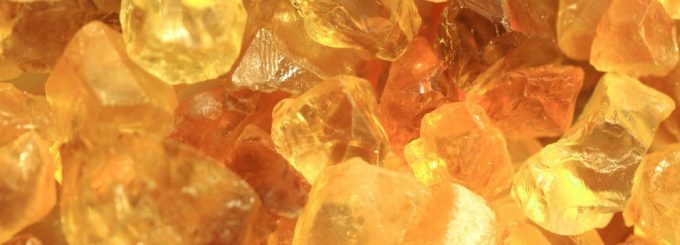Gemstone Spotlight: Citrine

Citrine is a fabulous gem that is a member of the esteemed quartz family. It is closely related amethyst and chalcedony, but has a number of properties which are distinct and responsible for its beauty and value.
Characteristics
Citrine comes in colors which range from lemon yellow to orange and brown. High color saturation results in a tone that is even throughout, which corresponds to a higher asking price. Reddish orange is the most popular color, and is usually found in places like Uruguay or Brazil. Natural gems are more valuable than those which have been treated. The stone is comprised mostly of oxygen and silicon, and is usually discovered within geodes. Geodes are formed whenever bubbles become trapped inside volcanic lava or rock. As the outer rock becomes harder, an oval or circular shape will form that leaves an open space within, and over millions of years the hollow space will be filled by liquids that are full of silicon dioxide, which eventually crystallizes into citrine.
As with other gemstones, clarity is important. A citrine stone which is clear will command higher value than one that isn’t. No cracks are blemishes should be present. Coloration should be consistent throughout. The word “citrine” is taken from the Latin word “citrus” which is a reference to fruit such as oranges and mangoes, which share the same color. Citrine is closely associated with the sun and health and some have combined it with essential oils for usage in their massage therapy. Citrine has been worn in jewelry since antiquity, and both the Greeks and Romans were familiar with it.
How To Shop For Citrine
The most expensive variant is the Madeira Citrine, which can be found in Brazil. Generally speaking, lighter gems will cost less than their darker counterparts. In Mohs scale, citrine has been given a hardness rating of seven which means it can be readily cut into any shape you desire. Its combination of being available in big sizes combined with its affordability compared to other gems allows jewelers to cut it into shapes which are both interesting and eye catching.
How To Wear And Care For Citrine
Citrine is a robust stone that can be worn daily in a variety of jewelry. It is an outstanding candidate for concave cuts or any cut where the gemstone shaping causes excessive waste. Citrine looks great in rings, bracelets or necklaces and functions well with both silver and white gold. It is the November birthstone and although it is durable like other gems it is susceptible to scratching. As such, it should never be mixed with other gems and when not worn is best placed in a box lined with fabric.
When it comes to cleaning, all you need to use is basic water and soap, with a soft paint or toothbrush for cleaning. Some owners use fancier tools such as ultrasonic cleaners, and this is fine so long as the stone hasn’t been dyed or treated.


